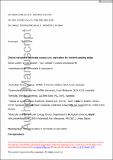Files in this item
Diurnal variation in freshwater ecoacoustics : implications for site-level sampling design
Item metadata
| dc.contributor.author | Linke, Simon | |
| dc.contributor.author | Decker, Emilia | |
| dc.contributor.author | Gifford, Toby | |
| dc.contributor.author | Desjonquères, Camille | |
| dc.date.accessioned | 2021-03-24T17:30:04Z | |
| dc.date.available | 2021-03-24T17:30:04Z | |
| dc.date.issued | 2020-01-01 | |
| dc.identifier | 272934372 | |
| dc.identifier | 7c6abd8b-054c-4526-8809-ef25da84cb23 | |
| dc.identifier | 85058230764 | |
| dc.identifier.citation | Linke , S , Decker , E , Gifford , T & Desjonquères , C 2020 , ' Diurnal variation in freshwater ecoacoustics : implications for site-level sampling design ' , Freshwater Biology , vol. 65 , no. 1 , pp. 86-95 . https://doi.org/10.1111/fwb.13227 | en |
| dc.identifier.issn | 0046-5070 | |
| dc.identifier.other | ORCID: /0000-0002-6150-3264/work/89178825 | |
| dc.identifier.uri | https://hdl.handle.net/10023/21709 | |
| dc.description | Funding: SL was supported by ARC DECRA DE130100565. ED was supported by a Griffith University IPRS scholarship. CD was supported by a ENS PhD grant. | en |
| dc.description.abstract | Ecoacoustic methods are increasingly used to monitor the state of populations and ecosystems. In freshwater environments, they present the clear advantages of being non-invasive, reducing bias, and providing continuous observations instead of only limited sampling snapshots in time. However, similar to standard bioassessment methods, temporal variation and choice of indicators can greatly influence ecoacoustic assessments, highlighting the importance of sampling and analysis design. In this study, we quantified diurnal variation in underwater sound and its effect on sampling regimes for two waterholes in the Einasleigh River, Northern Australia. Recording continuously for 6 days, and subsampling 5 s every 10 min, we found 22 distinct sounds that were emitted by fish, Hemiptera and Coleoptera as well as another 22 of abiotic or unknown origin. Through rarefaction analyses, we found that subsampling the data to 60% of the recorded sound events resulted in capture of most of the 44 identified sound types. Temporal heterogeneity—patchy sound events through time—needs to be considered when maximising detected sound events. Reducing the sampling interval from every 10 min to half-hourly or hourly had a much greater effect on capturing all sound types compared to the number of days recorded or the length of the recording. Overall, only 10–20% of the sound events need to be annotated for most sound types to be described; for example, restricting analysis of the days recorded to only three and the recording interval to 0.5–1 s. Acoustic indices were dominated by three main event types—a diurnally flowing creek, a nocturnal chorus of Hemiptera, as well as a dawn chorus of terapontid fishes. We conclude with two key messages: First, a select group of informative signals can be monitored using very simple methods—namely, converting an audio stream into indices using freely available software. Second, however, to detect less acoustically dominant sound events, manual annotation or single call processing will still be needed. While these findings are encouraging, similar analysis will need to be conducted within other freshwater ecosystems before general conclusions about optimal sampling regimes can be drawn. | |
| dc.format.extent | 10 | |
| dc.format.extent | 451929 | |
| dc.language.iso | eng | |
| dc.relation.ispartof | Freshwater Biology | en |
| dc.subject | Biodiversity survey | en |
| dc.subject | Biomonitoring | en |
| dc.subject | Conservation technology | en |
| dc.subject | Ecoacoustics | en |
| dc.subject | Fish | en |
| dc.subject | QH301 Biology | en |
| dc.subject | SH Aquaculture. Fisheries. Angling | en |
| dc.subject | Aquatic Science | en |
| dc.subject | DAS | en |
| dc.subject | SDG 15 - Life on Land | en |
| dc.subject.lcc | QH301 | en |
| dc.subject.lcc | SH | en |
| dc.title | Diurnal variation in freshwater ecoacoustics : implications for site-level sampling design | en |
| dc.type | Journal article | en |
| dc.contributor.institution | University of St Andrews. School of Biology | en |
| dc.identifier.doi | https://doi.org/10.1111/fwb.13227 | |
| dc.description.status | Peer reviewed | en |
This item appears in the following Collection(s)
Items in the St Andrews Research Repository are protected by copyright, with all rights reserved, unless otherwise indicated.

